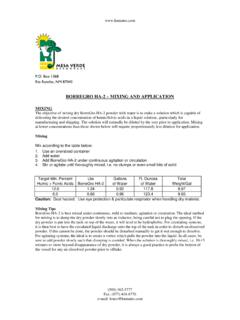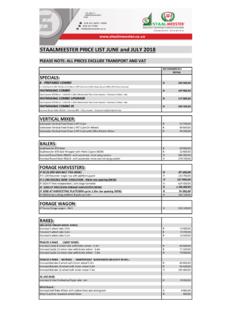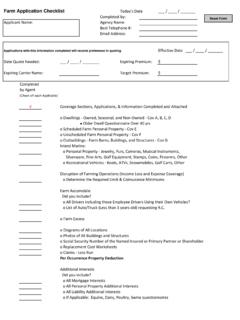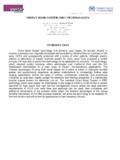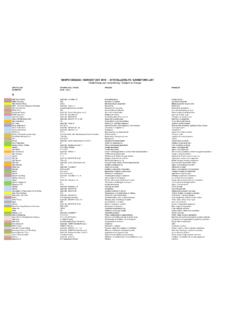Transcription of Lasting Grasshopper Protection with Modern Baits
1 Lasting Grasshopper Protection with Modern Baits Semasore for Quick Knockdown How To Use Them Modern Baits provide Lasting Protection from grasshoppers one which: * Kills grasshoppers at their source -- the hatching beds -- where they are concentrated, before they can migrate to your crop. * Persists throughout the hatching and growing season and at least through the following year. * Provides quick-kill of any survivors from the hatching beds or migrants from other areas which might threaten your crop. Semaspore (the Nosema locustae protozoa attached to wheat bran) is the bait which is applied to the hatching beds -- grassy areas, particularly those with southern exposure and more-sandy soil. This biological agent is only toxic to grasshoppers, killing about half those in the hatching area, and infecting most of the remainder.
2 These infected survivors (which eat little and lay few and infected eggs) are necessary to infect new hatchlings and migrants, through cannibalism -- this provides the persistent Protection . The disease also carries-over to the next year via the infected egg cases and infected cadavers which overwinter. Why Use Semaspore They are the cost-effective way to eliminate grasshoppers, because: * They work: both are approved by USDA-APHIS for Grasshopper control. Baits based on Nosema locustae were originally developed by the USDA. Semaspore has been tested extensively by US and other government agencies, and by universities in many countries. * Semaspore provides enduring Protection , necessary because grasshoppers hatch over about a six week period.
3 Cannibalism also kills grasshoppers which migrate through the treated area. Semaspore carries over to the next year, as well. Modern chemicals won t endure. Waiting until a crop is infested and then using chemicals won t reduce the Grasshopper migration from the hatching beds. They will simply replace those killed in the crop. Also, without treating the hatching beds, the grasshoppers will generally be back the next year. * The Semaspore approach attacks younger grasshoppers, which are easiest to kill, Waiting until they infest a crop and using chemicals means the grasshoppers are older and harder to kill. Also, killing them in hatching beds reduces the competition for food there, which lessens the need for survivors to migrate to crops.
4 * The approach is inexpensive. It s not necessary to treat the whole crop, just its boundaries and the neighboring hatching beds (or even just the hatching hot spots within them). Other benefits from the Semaspore approach: * Semaspore is non-toxic, except to grasshoppers, and are preferred for long-term Protection since they have little or no effect on grasshoppers predators/parasites. * Bran Baits are easy to apply. Inexpensive spreaders are available, appropriate to different size areas, and airborne spreaders are easily modified to accommodate bran. When To Apply Semaspore Apply Semaspore when immature grasshoppers in hatching beds number 10/sq yd. The USDA believes 10 will damage rangeland (fewer for cropland).
5 More than 20 may require repeat Semaspore treatments or more than the nominal 1 lb/ acre amount. Semaspore is used on young grasshoppers -- when most are 3rd instars, which are 4 weeks old, 1/2 long, and have wing buds. It kills younger grasshoppers sooner, and more of them, but then fewer are left around to infect others. Semaspore alone is not recommended for 5th instars, nearly 1 , because they do damage before dying. Apply Semaspore when grasshoppers are eager to eat -- sunny, warm days -- and when rain isn t expected for 8 hours (this insures the bran is eaten before it can be damaged). How To Apply Semaspore is easily applied with applicators appropriate to the infested area -- aerial application (we can identify aerial applicators near you or provide instructions for easy modification of airborne sprayers), pneumatic sprayers or seed broadcasters, and whirlybird spreaders or hand application.
6 Hopper exits must be shut low, and agitators used to keep the bran flowing. We can provide sources for effective, inexpensive spreaders. CROPLAND, NURSERIES, LAWNS AND GARDENS are generally not hatching areas. Here, Semaspore is applied to the surrounding hatching areas for persistent infection/killing of the emerging grasshoppers (young grasshoppers are generally still in the hatching areas). Semaspore, may have to be replenished for severe outbreaks. PASTURES AND RANGELAND also include the hatching beds. Here, field scouting will identify them (see Grasshopper CONTROL FACTS), areas where the vegetation is heavier, and Semaspore should be applied to them. How Does Semaspore Work Semaspore is the Nosema locustae spore fixed to wheat bran with a sweetener -- both attract grasshoppers.
7 After young grasshoppers eat Semaspore, they consume less within a week and in 2 weeks, sometimes longer, about 50% die with 50% or more of the remainder weak, infected, and eating 75% less. Survivors are necessary to spread the disease to new hatchlings and immigrants, through natural cannibalism, which provides the persistent Protection . Also, if any of the infected should lay eggs, these will be reduced by 60-80%, and the egg pod infected to carryover the disease to next year. Infected cadavers also overwinter to infect next year s grasshoppers. These results have been documented in numerous tests by the USDA and others. Infected grasshoppers develop a very large number of the spores within them, so that the cannibalizing grasshoppers get a much greater dose than from the initial Semaspore application.
8 Consequently, the disease acts faster on the cannibalizers. Also, when Semaspore is used, dead grasshoppers aren t often seen -- they re eaten too quickly by the survivors. Instead, Semaspore effectiveness is evidenced by the steady decrease in Grasshopper numbers, and by some infected, weak survivors which aren t doing damage. Semaspore infects at least 90 species of grasshoppers, the black field cricket, and some other crickets and locusts. However, it is completely non-toxic to anything else, not affecting humans, pets, and the over 250 natural grasshoppers enemies. Semaspore comes ready to use in 1, 5 and 50 lb containers which can be stored up to 6 weeks in a cool, dry place -- refrigeration extends shelf-life significantly.
9 Grasshopper Control Facts * Grasshoppers hatch when temperatures reach 60-70 deg. F, and hatching lasts 4-7 weeks, the rate increasing with temperature. Peak hatch may occur a month after it starts. The hatch is greater if the preceding fall was warm, dry and long, with more adults laying eggs longer. * Grasshoppers generally mature through 5 instar stages into adults, each instar involving a molt. An instar lasts for about 10 days with adults formed after 50 days. If Semaspore is applied about the 3rd instar, it has time to work before damage becomes significant. Also, Semaspore slows Grasshopper development as it slows their consumption. * Half of adult grasshoppers are females which can lay 8 or more egg pods that contain 20-100 eggs each, and eggs are not affected by winter, generally, because of a diapause stage.
10 For warm and dry conditions 200-400 eggs result for each female, and 8 grasshoppers/sq yd can, even with 75% mortality to originals and hatchlings, multiply into 50-100/sq yd the next year. Treat them this year! * Young consume 14 times as much per day as a 3rd instar; destruction increases nearly times with each instar -- early treatment is obviously more cost effective. Grasshoppers consume both dry and leafy forage with eastern versions tending more to leafy. Most seem to be attracted to sources of protein: , bran and other grasshoppers. Semaspore increases cannibalism since it weakens grasshoppers, making them easier to catch. * Ten adults/sq yd are economically damaging to rangeland, according to the USDA.



